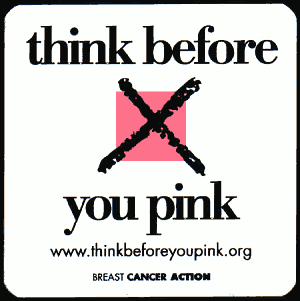I've shared my feelings about this month-long marketing extravaganza in a previous post, along with a little background on the origin and history of pink ribbons and breast cancer. You can read more about that here. Unfortunately, not much has changed in the world of pinkwashing since I wrote that post a year ago. In fact, it appears things are getting worse.
First, however, the good news is that our awareness of this practice is increasing. This is evidenced by the creation of a new word to describe the phenomenon, i.e. pinkwashing. The term comes from a mash up of the words pink - the color of the ribbon used to commemorate breast cancer, and whitewashing - which means to gloss over or cover up vices or scandals (1). The Urban Dictionary defines pinkwashing as "the use of breast cancer by corporate marketers in which companies promote their products with claims to donate a percentage of proceeds to the cause" (2). In the spirit of creating new words, let's throw in "profitizing" while we're at it because that's exactly the action that is occurring in what has become the industry known as breast cancer.
Now the bad news. Sadly, it's no longer uncommon for corporations to put profits before the welfare of people. However, things have gone from strange to bizarre considering the fact that joining the long line of companies marketing their products under the pink ribbon is the queen of breast cancer charities - the Susan G. Komen Breast Cancer Foundation. Evidently, the Komen Foundation has enlisted a company to manufacture a fragrance for them called Promise Me (4). The slogan listed on the ShopKomen webpage reads, "purchase with purpose to end breast cancer forever" (4). Have you ever wondered how much of the purchase price of a product that is marketed as "pink" actually goes toward the noble mission to "end breast cancer forever"? At ShopKomen it's 25% (5) (see the small print at bottom of the Komen webpage).
Now, if you're reading this blog you are probably clued in to the fact that the beauty industry is unregulated and as a result most beauty care products, including fragrances, contain chemicals that are proven to be unhealthy. Can you believe that the safety testing of personal care products is left up to the manufacturers? You read that correctly! According to the Environmental Working Group, they police themselves. So, considering this revelation, it will probably come as no surprise to learn that the original Komen Promise fragrance contained at least 2 chemical toxins (8):
• Galaxolide – a synthetic musk that works as a hormone or endocrine disruptor and has been detected in blood, breast milk, and even newborns.
• Toluene – a potent neurotoxicant linked to a variety of demonstrated negative health effects and is widely known as one of the toxic trio. Toluene is banned by the International Fragrance Association.
HELLO!! Endocrine disrupting chemicals are linked to cancer (6). This is outrageous and appalling to me. The Susan G. Komen Foundation is an organization whose mission is to "eradicate breast cancer as a life-threatening disease by advancing research, education, screening, and treatment" (3), yet they are marketing and selling a product containing chemicals that are suspected cancer causing agents.
That's why at this wonderful time of year, when everything is awash in pink, it is especially important to "think before you pink." This phrase, coined by Breast Cancer Action, suggests we ask the following questions before we generously support a charity or buy a pink ribbon product (9):
- Where does the money raised by pink ribbon products go?
- How much money goes towards breast cancer programs and services?
- How are the funds being raised? For example, is it through the sale of cosmetics that contain potential cancer causing chemicals?
- What types of programs are being supported? Is the money being used to conduct research to understand the causes of breast cancer, or in support of the prevention of the disease?
(1) Wikipedia - definition of whitewashing - http://en.wikipedia.org/wiki/Whitewash_%28censorship%29
(2) Urban Dictionary - pinkwashing - http://www.urbandictionary.com/define.php?term=pinkwashing
(3) Susan G. Komen Breast Cancer Foundation - http://www.ncbi.nlm.nih.gov/pmc/articles/PMC1508105/
(4) Shop Komen - http://www.shopkomen.com/cart.php?m=product_detail&p=1687
(5) Shop Komen homepage - http://www.shopkomen.com/
(6) http://www.ewg.org/skindeep/2011/04/13/why-this-matters/
(7) Endocrine Society - http://www.endo-society.org/journals/scientificstatements/upload/edc_scientific_statement.pdf
(8) Breast Cancer Action - Think before you pink - https://org2.democracyinaction.org/o/6098/p/salsa/web/thank_you_page/public/thankYou.sjs?thank_you_page_KEY=1654
(9) http://bcaction.org/our-take-on-breast-cancer/politics-of-breast-cancer/the-cancer-industry/#anchor2







